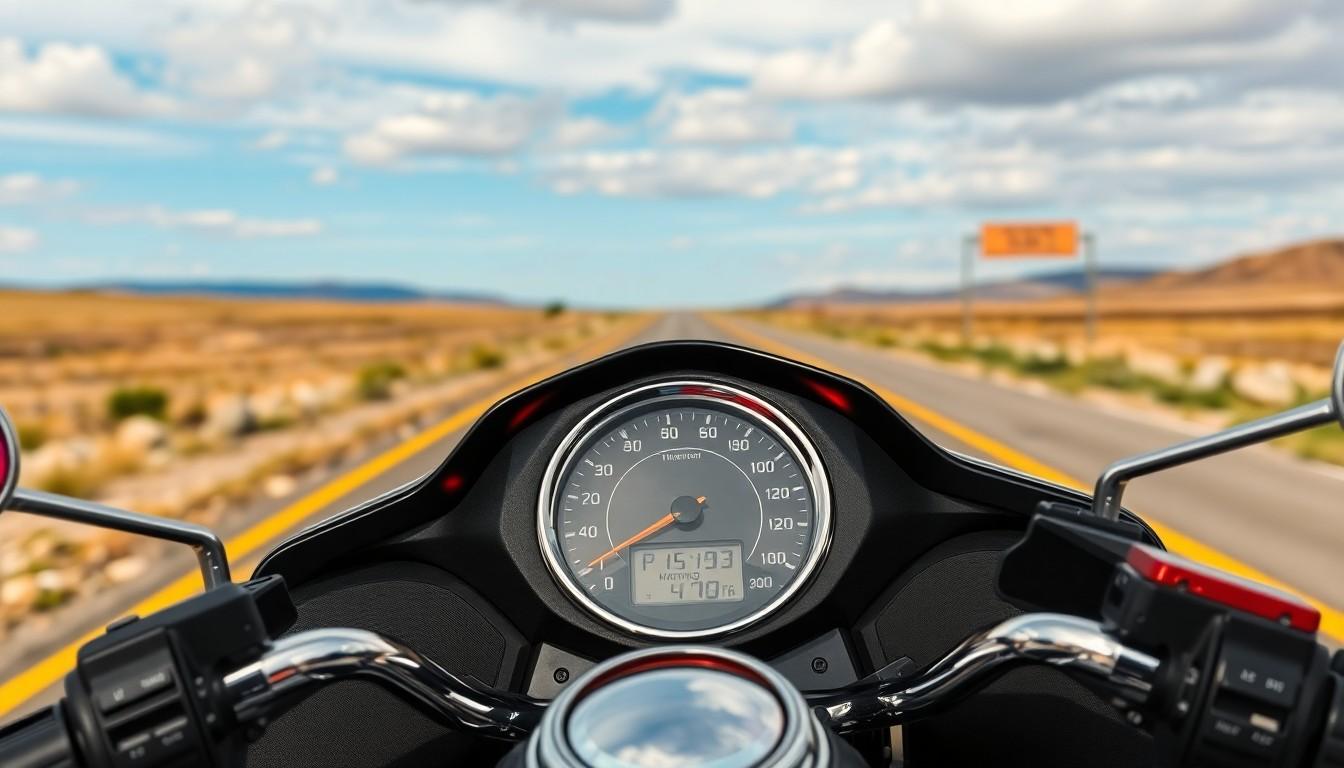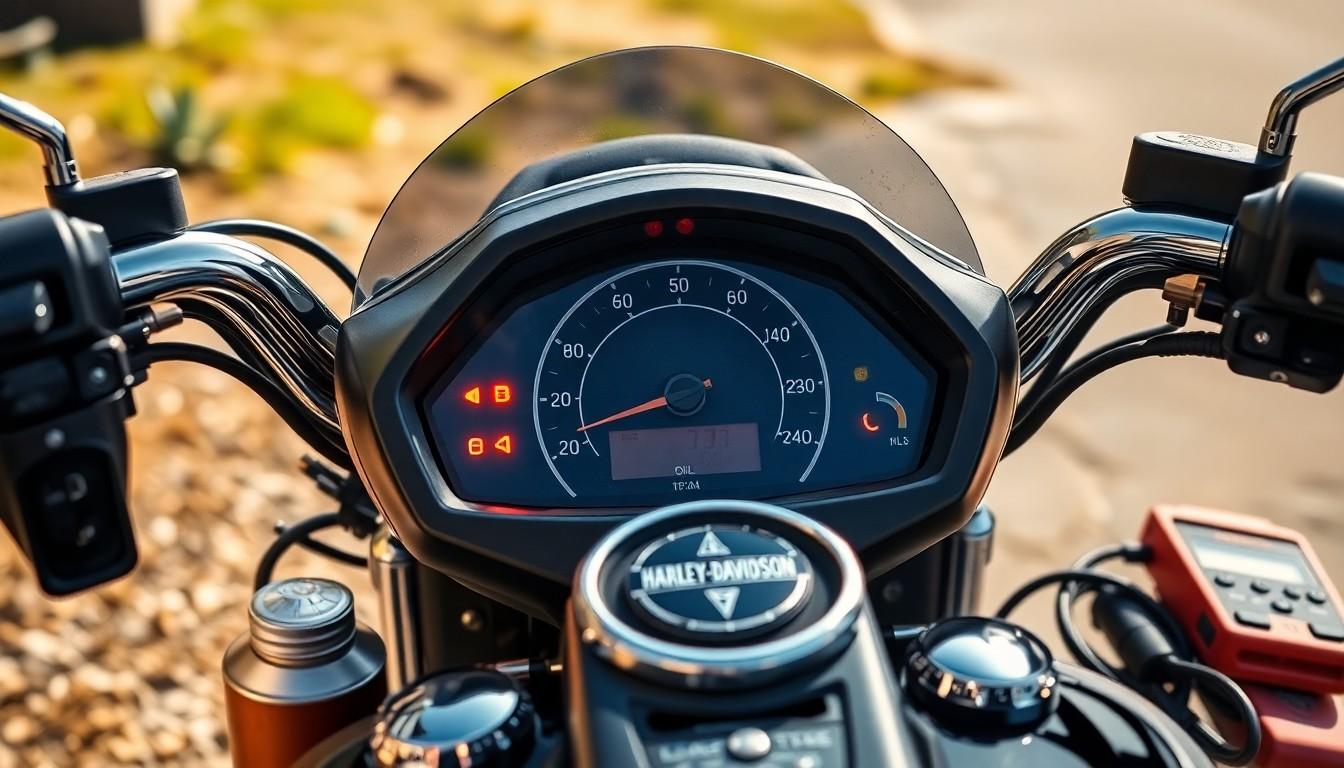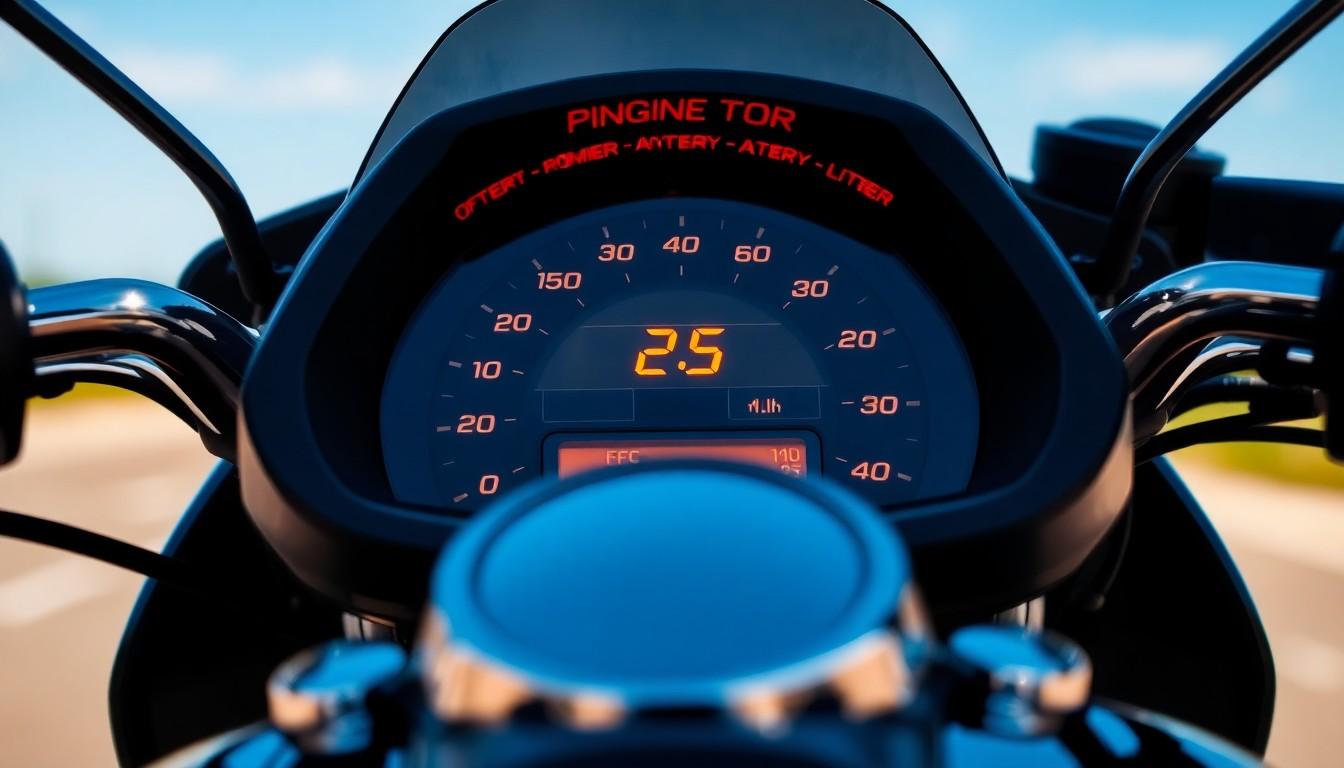Riding a Harley-Davidson motorcycle isn’t just about the freedom of the open road—it’s also about understanding what your bike is telling you. Those warning lights on your dash aren’t just colorful decorations; they’re critical communication tools between you and your beloved machine.
We’ve all been there: cruising along when suddenly an unfamiliar symbol illuminates on the dashboard. Whether it’s the enigmatic check engine light, battery indicator, or oil pressure warning, knowing what these lights mean can be the difference between a minor adjustment and a major repair. In this comprehensive guide, we’ll decode all the Harley-Davidson dash warning lights so you can ride with confidence and address potential issues before they become roadside emergencies.
Understanding Harley Davidson Dashboard Warning Lights
Harley Davidson motorcycles feature sophisticated diagnostic systems that communicate through dashboard warning lights. These indicator lights serve as an early detection system for potential problems with your bike’s performance. Each symbol on your dashboard corresponds to a exact component or system that requires attention.
Most Harley models display warning lights in a consistent pattern, though positioning may vary slightly between different motorcycle series. The primary warning indicators include the check engine light, oil pressure warning, battery voltage alert, and ABS system notification. Modern Harleys also incorporate additional indicators for security systems, traction control, and cruise control functionality.
Color coding plays a crucial role in the warning light system. Red lights typically indicate serious issues requiring immediate attention, such as engine overheating or critical oil pressure loss. Yellow or amber lights suggest less urgent concerns that still need addressing, like minor electrical issues or maintenance reminders. Green and blue indicators generally provide operational status information rather than warnings.
Dashboard warning lights activate during the motorcycle’s power-up sequence as part of the system’s self-diagnostic routine. This brief illumination pattern is normal and allows riders to verify all indicators are functioning properly. Lights that remain on after the initialization cycle or illuminate while riding warrant investigation according to your owner’s manual guidelines.
Regular familiarization with your exact model’s warning light configuration enhances your ability to respond appropriately to dashboard alerts. Consulting your motorcycle’s owner’s manual provides detailed information about each indicator’s meaning and the recommended action when activated. Understanding these warning symbols empowers you to make informed decisions about whether to continue riding or seek immediate mechanical assistance.
Common Harley Davidson Warning Light Indicators

Harley Davidson motorcycles feature exact warning lights that alert riders to potential issues with various systems. Understanding these indicators helps maintain your bike’s performance and prevents unexpected breakdowns on the road.
Engine Check Light
The engine check light (also called the check engine light or CEL) appears when the motorcycle’s onboard diagnostic system detects a trouble code. This indicator signals potential problems with your engine, body control module, speedometer, or anti-lock braking system. To access trouble codes yourself, hold down the trip reset button while turning the ignition from off to on position. You can then cycle through different diagnostic categories to view DTCs (Diagnostic Trouble Codes) displayed on your dash.
Oil Pressure Warning
The oil pressure warning light illuminates in red when engine oil pressure drops below safe operating levels. This critical indicator requires immediate attention as continued operation can cause severe engine damage. Pull over as soon as it’s safe to do so if this light appears during your ride. Red warning lights on Harley Davidson motorcycles always indicate serious faults that shouldn’t be ignored, making this one of the most important indicators to monitor.
Battery Voltage Alert
The battery voltage alert notifies riders about electrical system issues, particularly problems with battery charge levels or the charging system itself. This amber-colored light suggests a fault requiring attention but isn’t typically an emergency situation. Regular battery maintenance and checking connections can prevent many issues that trigger this warning. Address this indicator promptly to avoid getting stranded with a dead battery during your next ride.
ABS Warning Light
The ABS warning light activates when a fault occurs in the Anti-lock Braking System of your Harley Davidson. This amber or yellow indicator shows that your ABS isn’t functioning correctly, though conventional brakes typically remain operational. Have a qualified technician inspect the system promptly to ensure optimal braking performance. Riding with a malfunctioning ABS compromises your safety, especially in emergency braking situations or adverse weather conditions.
Critical Warning Lights That Require Immediate Attention

Some Harley-Davidson dashboard warning lights demand urgent action to prevent potential damage or dangerous situations. These critical indicators alert riders to serious issues that shouldn’t be ignored, as they often signal problems that could lead to costly repairs if not addressed promptly.
Temperature Warning Light
The Temperature Warning Light appears as a thermometer icon in red or amber on your Harley’s dashboard. This critical indicator activates when the engine is overheating, signaling a potentially serious situation that requires immediate attention. Continued operation with an illuminated temperature warning light can result in severe engine damage. Pull over as soon as it’s safe when this warning appears, and allow your motorcycle to cool down before inspecting the cooling system for issues. Overheating problems might stem from low coolant levels, cooling system blockages, or radiator malfunctions that need immediate resolution to protect your engine’s integrity.
Security System Alert Light
The Security System Alert Light on a Harley-Davidson typically appears as a key icon or padlock symbol in red or amber. Different flash patterns indicate exact security statuses—a flash every three seconds signals the security system is armed and protecting your motorcycle. The light remains on for four seconds before turning off when the system is properly disarmed. A continuously illuminated red Security Light on your speedometer indicates an active issue within the security system that requires attention. These problems might involve the immobilizer, faulty sensors, or other security components that could potentially prevent your motorcycle from starting or operating correctly. Addressing security system warnings promptly helps avoid unexpected complications during your rides and maintains your bike’s theft protection features.
Informational Indicator Lights on Your Harley

Informational indicator lights on Harley-Davidson motorcycles provide essential status updates about your bike’s operations. These lights don’t typically signal problems but instead communicate the current state of various systems and functions on your motorcycle.
Turn Signal Indicators
Turn signal indicators on Harley-Davidson dashboards appear as green or blue flashing lights. They illuminate when you’ve activated either your left or right turn signals, providing a visual confirmation that your turning intention is being communicated to other motorists. These indicators continue flashing until you cancel the turn signal after completing your maneuver, serving as a helpful reminder to deactivate them.
High Beam Indicator
The high beam indicator displays as a blue light on your Harley’s dashboard. This light activates whenever you’ve engaged your motorcycle’s high beam headlight setting. It’s an important reminder that your brighter headlight option is currently in use, helping you avoid accidentally blinding oncoming traffic in nighttime riding conditions.
Neutral Position Light
Neutral position lights on Harley-Davidson motorcycles typically illuminate as green or blue indicators. This light confirms your transmission is currently in neutral gear, signaling the bike is ready for starting or for shifting into a drive gear. Many riders rely on this indicator while stopped at traffic lights or when parking their motorcycle, as it provides immediate confirmation of the transmission’s status without requiring physical testing of the gear position.
How to Respond to Warning Lights on Your Harley Davidson

Knowing how to properly respond to dashboard warning lights on your Harley Davidson can save you from expensive repairs and potential roadside emergencies. Taking appropriate action based on the exact warning light illuminated ensures your motorcycle remains in optimal condition and keeps you safe on the road.
Diagnostic Steps
Identifying the exact warning light is the first crucial step when troubleshooting dashboard indicators on your Harley Davidson. Always refer to your owner’s manual for detailed explanations of each warning light and recommended actions exact to your motorcycle model. Access trouble codes for the Check Engine Light by holding down the trip reset button while turning the ignition from off to on, which allows you to cycle through categories and note the Diagnostic Trouble Codes (DTCs) displayed on your dash. Perform basic checks related to the illuminated warning light, such as inspecting battery connections, checking oil levels, or examining the brake system to potentially resolve simpler issues before seeking professional help.
When to Contact a Professional
Red warning lights on your Harley Davidson dashboard demand immediate attention, including the Battery Warning Light and Oil Pressure Light, as ignoring these critical alerts can lead to dangerous malfunctions or costly repairs. Complex issues requiring advanced diagnostic work, such as interpreting trouble codes or addressing faults within the electronic control module, body control module, or anti-lock braking system (ABS), are best handled by a Harley-Davidson dealership service department or qualified technician. Contact a professional immediately if you’re unsure about the meaning or implications of a warning light, especially if you’re uncomfortable with electrical diagnostic work, to ensure the issue is addressed correctly and safely before continuing your ride.
Maintaining Your Harley to Prevent Warning Light Issues

Regular maintenance keeps your Harley-Davidson running smoothly and prevents those dashboard warning lights from illuminating unexpectedly. Proper upkeep addresses potential problems before they trigger warning indicators, saving you from roadside headaches and costly repairs.
Regular Oil Maintenance
Oil checks form the foundation of preventative motorcycle maintenance. Checking your oil level weekly ensures it remains within the recommended range, protecting your engine from damage and preventing the oil pressure warning light from activating. Fresh oil and filter changes according to your model’s service intervals maintain proper lubrication throughout the engine system.
Cooling System Care
Coolant maintenance directly affects your engine’s temperature regulation. Inspecting coolant levels during your pre-ride checks helps identify potential leaks or low fluid conditions before they trigger the red temperature warning light. Look for puddles under your parked motorcycle and inspect hoses for wear, cracks, or loose connections that might compromise the cooling system.
Battery and Electrical System Upkeep
Battery maintenance prevents many electrical warning lights from appearing. Clean battery terminals free from corrosion ensure proper electrical flow throughout your Harley’s systems. Checking battery voltage regularly with a multimeter identifies weakening batteries before they fail completely. Many modern Harleys feature sophisticated electrical systems that depend on stable power to function correctly.
Fuel System Monitoring
Fuel system attention prevents both performance issues and warning light activation. Keeping your tank filled above the one-gallon reserve level prevents the amber low fuel lamp from illuminating during your rides. Using quality fuel and fuel system cleaners helps maintain injector performance and prevents check engine lights related to fuel delivery problems.
Following Factory Service Schedules
Scheduled maintenance according to Harley-Davidson’s service manual addresses potential issues systematically. These factory-recommended intervals are designed specifically for your motorcycle model and riding conditions. Professional technicians can spot developing problems during routine service appointments, often before they trigger dashboard warning lights.
Diagnostic System Checks
Diagnostic checks reveal underlying issues before warning lights appear. Using the onboard diagnostic system by holding down the trip reset button while turning the ignition from off to on helps retrieve any stored trouble codes. This proactive approach identifies developing problems that haven’t yet triggered visible warning lights but might be recorded in the motorcycle’s computer memory.
Conclusion
Knowing your Harley-Davidson’s warning lights is an essential skill for every rider. These dashboard indicators serve as your bike’s voice alerting you to everything from minor maintenance needs to critical issues requiring immediate attention.
By understanding what each light means and how to respond appropriately you’ll ride with greater confidence and avoid potentially costly roadside breakdowns. Remember that red warnings demand immediate action while amber lights typically allow for scheduled maintenance.
Regular preventative maintenance remains your best defense against seeing these warning lights in the first place. We recommend keeping your owner’s manual handy and developing a relationship with a trusted Harley technician.
Ride smart by heeding these important signals your motorcycle sends and you’ll enjoy many more trouble-free miles on your Harley-Davidson.
Frequently Asked Questions
What do the warning lights on my Harley-Davidson dashboard indicate?
Warning lights on a Harley-Davidson dashboard serve as communication tools between you and your motorcycle. They alert you to potential issues ranging from minor adjustments to serious problems requiring immediate attention. Each light corresponds to a specific component or system needing attention, such as engine problems, oil pressure issues, battery voltage concerns, or ABS system notifications.
Why do all dashboard lights illuminate when I start my Harley?
This is normal and part of your motorcycle’s self-diagnostic routine. When you first turn the key, all warning lights briefly illuminate as the bike performs a system check. This allows you to verify that all indicator bulbs are working properly. If any lights remain on after the bike starts and runs for a few seconds, it indicates a potential issue that needs attention.
What’s the difference between red and yellow warning lights?
Red warning lights indicate serious issues requiring immediate attention. You should stop riding as soon as it’s safe to do so when you see a red light. Yellow or amber lights suggest less urgent concerns that should be addressed soon but may not require immediate action. Always consult your owner’s manual for specific guidance on each warning light’s severity.
What should I do if the engine check light comes on?
First, identify if it’s red (stop immediately) or yellow (can continue with caution). Check for obvious issues like loose gas caps or low fluid levels. If no simple fix is apparent, check your owner’s manual for guidance specific to your model. For persistent check engine lights, it’s best to have your motorcycle diagnosed by an authorized Harley-Davidson technician to prevent potential damage.
How can I prevent warning lights from appearing?
Follow a regular maintenance schedule including oil changes, battery checks, and fuel system care. Keep up with factory service intervals and address minor issues before they become major problems. Regularly check fluid levels, inspect electrical connections, and maintain proper tire pressure. Having periodic diagnostic system checks can identify potential issues before they trigger warning lights.
What does the ABS warning light mean on my Harley?
The ABS (Anti-lock Braking System) warning light indicates a potential issue with your motorcycle’s braking system. If illuminated, it means the ABS may not function properly during emergency braking. While normal brakes still work, the anti-lock feature may be compromised. This could be caused by a faulty sensor, low battery voltage, or ABS system malfunction. Have it checked by a qualified technician soon.
Is it safe to ride with a battery warning light on?
No, it’s not safe to continue riding with a battery warning light illuminated. This red warning indicates your charging system isn’t functioning properly, which could lead to complete electrical failure. Your motorcycle may soon stop running as the battery depletes. Pull over safely, check battery connections for corrosion or looseness, and contact roadside assistance or a Harley dealer for support.
What does the oil pressure warning light indicate?
The oil pressure warning light is critical and indicates inadequate oil pressure in your engine. If this red light illuminates while riding, stop immediately when safe to do so and turn off the engine. Check the oil level when the engine cools. Low oil levels, oil pump failure, or blocked oil passages can trigger this light. Continuing to ride with this light on can cause catastrophic engine damage.

